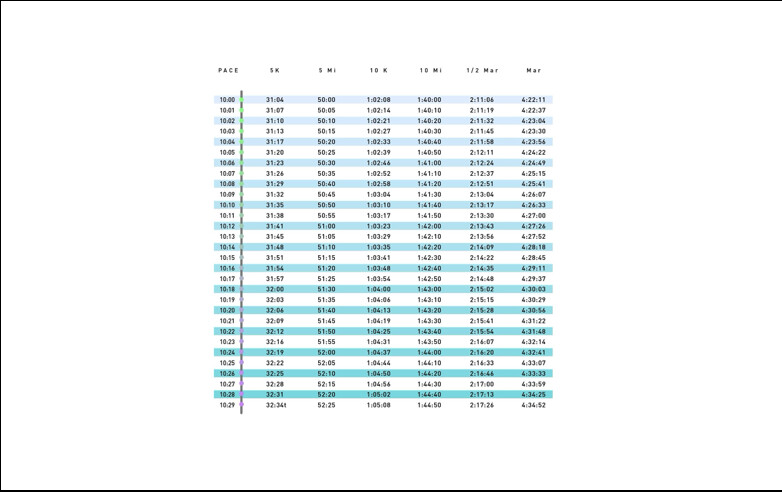Running News Daily
Running News Daily is edited by Bob Anderson. Send your news items to bob@mybestruns.com Advertising opportunities available. Train the Kenyan Way at KATA Kenya and Portugal owned and operated by Bob Anderson. Be sure to catch our movie A Long Run the movie KATA Running Camps and KATA Potato Farms - 31 now open in Kenya! https://kata.ke/
Index to Daily Posts · Sign Up For Updates · Run The World Feed
How Long Does It Take to Run a Mile?
Knowing the average pace can help you set new goals.
The best way to find your average running speed is by tracking your mile pace.

For example, say you go out for a three-mile race. You might start off running fast because of an adrenaline rush, then slow down once you realize you’re running too hard. But toward the end, when the finish is in sight you might catch a second wind and pick up speed again. This all results in different mile times.
Your average mile time, which will be the sum of all your mile times divided by the number of miles completed, may look different than each individual mile. The more you train, not only will your average mile pace drop, but each individual mile time will likely become closer in time to the others.
That’s why tracking your average mile time is a great way to monitor your progress. Plus, when you reach a new barrier—like the first time you run faster than a 10-minute mile, for example—it allows you to search out new goals in your running journey and also scope out your competition.
How long does it take to run a mile on average?
Based on real-life data from all public uploads to Strava from August 1 2022 to July 30 2023, the average mile time across the globe is 10 minutes and 25 seconds (10:25). That number adjusts based on gender: 10:02 for men and 11:17 for women. In the U.S., the average running speed is 9:54 and breaks down to a 9:32 mile pace for U.S. men and 10:37 for U.S. women.
These paces have changed since 2018 when the average global mile pace hit 9:48 and U.S. pace averaged 9:44.
Don’t fret if your current average time is a little off from those marks. Keep in mind that, while sizable, the dedicated Strava community doesn’t represent the entire running community.
What factors affect average running speed?
The following factors play a big role in every runner’s mile speed:
Gender
Age
Weather/wind
Nutrition and hydration
Injuries
Height
Weight
Terrain
The list could go on. Even what you think about or your mindset can affect how fast you run, and that’s under your control. Other factors, however—such as height and age—are things you obviously can’t change.
Also, according to recent number crunching at Runner’s World, based on data from platforms like MapMyRun, even the type of year you’re having has an effect on one’s average mile time and pace. From mid-April to mid-September—during the start and midpoint of the coronavirus pandemic—the average mile pace recorded was 8.5 percent slower compared with the same range in 2019, which the MapMyRun team attributes to a new or returning runner effect.
When it comes to age, one data analysis performed in 2010 and based on 10,000 U.S. runners who completed a 5K showed the average minutes per mile for runners of different ages. The average overall was 11:47 per mile. Men in the 16- to 19-year-old age range finished the run with an average pace of 9:34; women in the same age group finished in 12:09. The numbers gradually increased as the age groups got older.
In most cases, though, the gaps between the finishing times of the different age groups weren’t drastic. And you might not necessarily get slower with age. As Runner’s World has reported, many pro runners and average runners peak in their 30s, and even runners in their 70s can keep getting better with age.
Because of the many variables associated with running pace, it can be difficult to establish an across-the-board average running speed.
How fast should you run a race?
If you’re looking to find out what your average running pace should be to hit a specific time goal in a race, you’re in luck. Our Runner’s World Pace Charts (in both minutes per mile and kilometer) show what time a given pace will produce for six common race distances: 5K, 5 miles, 10K, 10 miles, half marathon, and marathon. As an example in the chart below, if you want to run under 1 hour and 45 minutes for a 10-mile race, you’d need to have an average pace of 10 minutes and 29 seconds per mile to accomplish your goal.
Use our charts as a reference point after you start training so you can know what average pace is necessary (and realistic) for your upcoming goal race.
How can you boost your average running speed?
If you want your average running pace to be faster, there are several steps you can take to improve, like figuring out how to breathe properly and mixing up your types of runs. You should also recognize the importance of nutrition and hydration.
Adopt a holistic approach to your training, doing regular conditioning workouts to improve your strength and flexibility in addition to running, as a stronger, mobile body can help you run faster and avoid injury.
What’s the fastest ever mile speed?
The fastest mile ever recorded was set by Hicham El Guerrouj, a Moroccan runner who ran a mile in 3:43.13 in 1999. Guerrouj was 24 years old at the time.
For women, the fastest mile ever was run by Faith Kipyegon, which she snagged just this month, with a time of 4:07.64.
If you’re looking for the fastest average running paces over the course of 26.2 miles, look no further than the world record holders in the marathon—Eliud Kipchoge (4:37.2 per mile) and Brigid Kosgei (5:06.8 per mile).
And just for fun, if Usain Bolt were to ever keep his jaw-dropping sprint going for a full mile at his peak ability, the Jamaican’s top speed in 2009 during his 9.58 world record 100-meter dash would have put him just over 27 miles per hour.
by Runner’s World
Login to leave a comment




